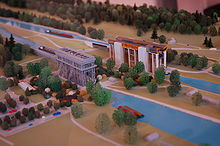Classification of European Inland Waterways

The Classification of European Inland Waterways are a set of standards for interoperability of large navigable waterways forming part of the Trans-European Inland Waterway network within Continental Europe and Russia. It was created by the European Conference of Ministers of Transport (ECMT; French: Conférence européenne des ministres des Transports, CEMT) in 1992,[1] hence the range of dimensions are also referred to as CEMT Class I–VII.
The size for each waterway is limited by the dimensions of the structures including the locks and boat lifts on the route.
Classification
Class I corresponds to the historical Freycinet gauge decreed in France during 1879. The larger river classification sizes are focused on the carriage of intermodal containers in convoys of barges propelled by a push-tug. Most of the canals of the United Kingdom have smaller locks and would fall below the dimensions in the European classification system. In 2004, the standards were extended with four smaller sizes RA–RD covering recreational craft, which had originally been developed and proposed via PIANC.[2] The proposal to add the recreational sizes was adopted by United Nations Economic Commission for Europe resolution 52.[3][4]
| Classification | Tonnage (t) | Length (m) | Breadth (m) | Draught (m) | Air Draft (m) | Notes |
|---|---|---|---|---|---|---|
| RA | 5.5 | 2.00 | 0.50 | 2.00 | "Open boat" | |
| RB | 9.5 | 3.00 | 1.00 | 3.25 | Cabin cruiser | |
| RC | 15.0 | 4.00 | 1.50 | 4.00 | "Motor yacht" | |
| RD | 15.0 | 4.00 | 2.10 | 30.00 | "Sailing boat" | |
| I | 250–400 | 38.5 | 5.05 | 1.80–2.20 | 3.70 | "Péniche" |
| II | 400–650 | 50.0–55.0 | 6.60 | 2.50 | 3.70–4.70 | Euro-barge |
| III | 650–1,000 | 67.0–80.0 | 8.20 | 2.50 | 4.70 | "Gustav Koenigs" |
| IV | 1,000–1,500 | 80.0–85.0 | 9.50 | 2.50 | 4.50; 6.70 | "Johann Welker" |
| Va | 1,500–3,000 | 95.0–110.0 | 11.40 | 2.50–4.50 | 4.95; 6.70; 8.80 | "Large Rhine" |
| Vb | 3,200–6,000 | 172.0–185.0 | 11.40 | 2.50–4.50 | 4.95; 6,70; 8,80 | 1×2 convoy |
| VIa | 3,200–6,000 | 95.0–110.0 | 22.80 | 2.50–4.50 | 6.70; 8.80 | 2×1 convoy |
| VIb | 6,400–12,000 | 185.0–195.0 | 22.80 | 2.50–4.50 | 6.70; 8.80 | 2×2 convoy |
| VIc | 9,600–18,000 | 270–280 | 22.80 | 2.50–4.50 | 8.80 | 2×3 convoy |
| 9,600–18,000 | 195–200 | 33.00–34.20 | 2.50–4.50 | 8.80 | 3×2 convoy | |
| VII | 14,500–27,000 | 285 | 33.00–34.20 | 2.50–4.50 | 8.80 | 3×3 convoy |
References
- ^ European Conference of Ministers of Transport (12 June 1992). Resolution No. 92/2 on New Classification of Inland Waterways (PDF) (Report). Retrieved 3 July 2012.
- ^ RecCom Working Group 8 (2000). Standards for the Use of Inland Waterways by Recreational Craft (Report). PIANC. p. 30–32. ISBN 2-87223-115-3. Retrieved 11 July 2012.
{{cite report}}: CS1 maint: numeric names: authors list (link) - ^ Edwards-May, David (3 July 2007). Classification of Recreational waterways (PDF) (Report). Lille: Stichting Recreatietoervaart Nederland. Retrieved 11 July 2012.
- ^ Working Party on Inland Water Transport (19 November 2004). "Resolution No.52" (PDF). European Recreational Inland Navigation Network. Geneva: Economic Commission for Europe Inland Transport Committee.
